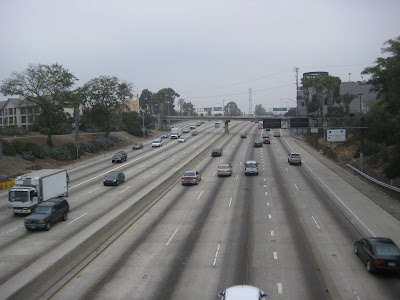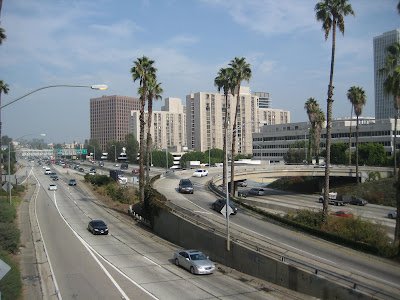Big Sur refers to both a long scenic stretch along the coast, starting south of Monterey, as well as a small 'city' in the middle of this region. There is not much civilization, but a lot of tourism. Highway One leads the stream of tourists in RVs (Wohnwagen), cars and on bicycles along this region.
Ever since far up in the north, people keep telling me about Big Sur, that it will be the most scenic and beautiful and stunning part of the whole coastal ride. One of the couchsurfing associated people in Santa Cruz said that you don't really see when you get there, there is no sign saying 'Big Sur region starts here', you just sense it. I got a lot of recommendations about what to see and do in Big Sur, and once more I realised that the information you get by talking to people is much more worth than anything you look up in the internet. And without internet, I'm very dependent on this old-fashioned source of information, which is great, and much better (the internet cafe where I started writing this post is the result of a random encounter after some coincidences, but this is a different story)
Sykes Hot SpringsI camped at Pfeiffer Big Sur State Park and took a two days break from cycling to hike to the Sykes hot springs, a 16 km hike. As the weather was good, I didn't take the tent, and as few things as possible in and on top of the very primitive Walmart backpack. The problem of leaving all my other stuff somewhere while being away for one night was not as easily solved as I hoped. I started talking to people again to get some information.
First to the Trailhead Station, from where the 'Pine Ridge Trail' to the Sykes camp starts, both to get information about the hike, and to ask about storing faciclities for luggage, hoping they would offer me to store things at the Station. But they wouldn't. I asked in the lodge next to the campground, and at the entrance kiosk. Everyone just sent me to the place where I had just come from, they would have more information. The last chance was the campground host (this is something like the janitor, Hausmeister, of the campground), who lives in a trailor opposite to the hiker/biker area. Started by explaining my plan and situation, without directely asking if they would take care of my stuff for one night, but secretly hoping they would offer exactely this. And they did! It was not a problem for them, I could just put my paniers beneath their trailor, where they would be safer than in the raccoon proof (Waschbaer-sicher) boxes at the hiler/biker site or in some treetrunk or bushes (actually I had looked for such places around the campground as well, and found a very convenient climbable treetrunk of about 3 meters height with a nice cavity on top, making luggage invisible from the ground, which would have been the solution, if I hadn't found the very friendly and helpful campground host). And finally I could start.




It was a 5 hours up and down walk that was eventually rewarded by a bath in the manmade pool of a warm spring in a very natural surrounding. Cooling down in the river and back to the hot spring again. Like a hot tub.
It felt remote, even though there were people around. Luckily they were around, as the trail was not very obvious and hard to find in the end, crossing a shallow stream a couple of times to reach the spring.



'Camp' doesn't mean that it's a campground. There are spots with fireplaces along the river before the hot spring, where you can pitch tents or just sleep. I set up my primitive camp. The ground was very uneven, so I spent most of the night crawling up the camping mat after slowly sliding down while turning around. Went for another 'swim' in the warm water the next morning. The way back felt much shorter.
The next day I sensed very sifferent muscles that hadn't been used so far when cycling.

 Henry Miller Memorial Library
Henry Miller Memorial LibraryThis was another not-to-miss recommendation. It is rather a bookstore than a library, and it is more than that. He wrote some controversial books that were first prohibited but later recognized as pioneering literature. He had lived in Big Sur for 15 years. The library was founded by a friend of Henry Miller. It is a cute wooden house with a big garden to relax, coffee and tea available for a donation, a cat strolling around, a guitar, a piano, free internet, and of course lots of good books. I mean really good books. Much of Henry Miller of course, but also many other authors, some rare ones that you might not find in normal bookstores. If I had a trailor, I would have bought a lot of books there.
Only cycled 46 km this day because I spent more that three hours in the book store.
 Big Sur Coast
Big Sur CoastFor me, the 'Big Sur feeling' started with or after this bookstore. Accompanied by its atmosphere, the scenery from now on was really stunning. On the pictures, it might just look like any of the other coast pictures of previous posts, but in reality it was different. More coast, but just more beautiful than before.




And about these invasive plants, that I was prevented to spread along the coast (see Post 'Approaching San Francisco' below): They don't seem to be a problem of northern California only, they grow everywhere:

So I don't need to feel bad about having carried the natural flag for a few miles. It's probably not due to touring cyclists that their seeds are spread along the coast.
I reached Kirk Creek campground at the end of the Henry-Miller day, late despite the short distance. Saw the sun setting in the ocean from the hiker/biker site, and found out that it sets at 6:25 already. The days get shorter.
Campground in the evening

Campground next morning

The next day was a long one again (112 km), from Kirk Creek to Morro Bay, which is a bigger city of around 10.000 people. The first half of the day was still part of the Big Sur section, this time in very dynamic fog. Met two cyclist from Switzerland during coffee break, two more cyclists appeared at the same little shop. So far, I haven't seen any cyclist from before San Francisco again.






After a long hill, I think Big Sur was over. The scenery changed from rocky, foggy coast to dry, hot wide fields, whenever the road led inland for a while.































































